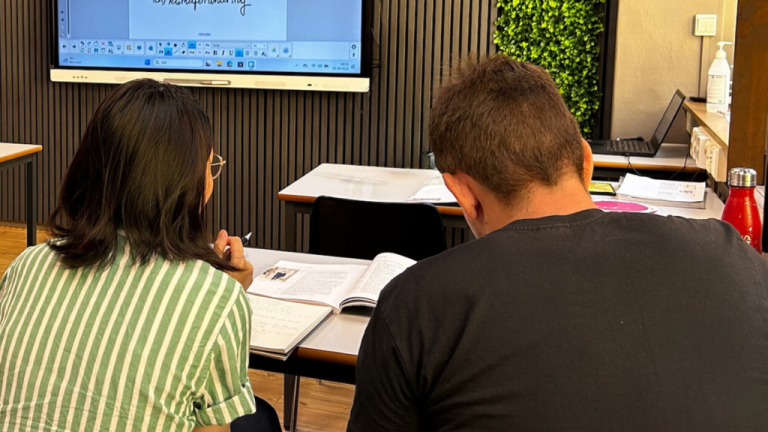Everything you need to know about Norskprøven
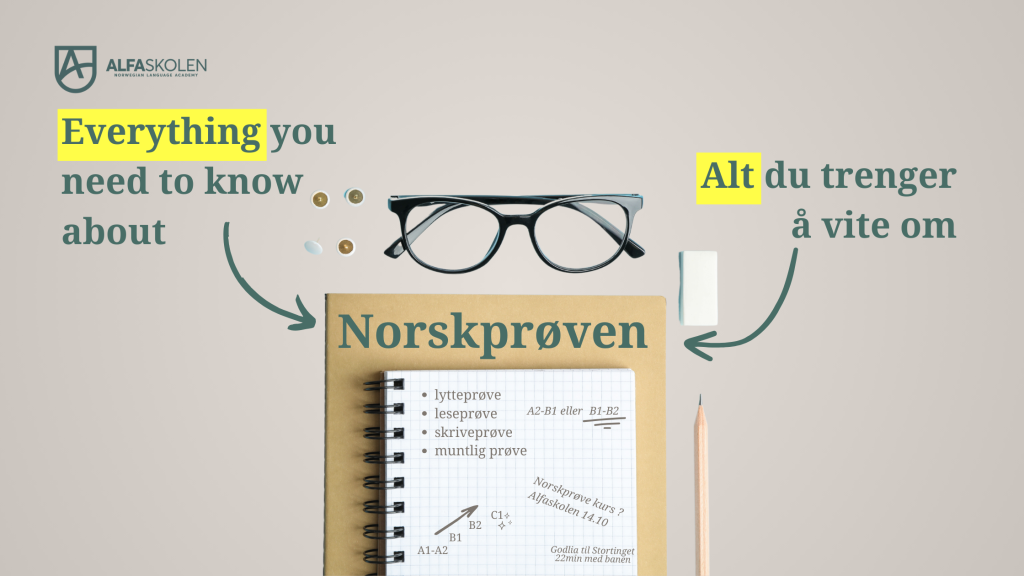
Are you planning to take the Norwegian language test (Norskprøve) soon? In this post, you’ll find all the information you need to prepare! We’ll go over what the Norskprøve is, how it’s structured, and provide practical tips and sample tasks to help you pass. Finally, you’ll also get information on how to register and what to expect from the results.
What is the Norskprøve?
The Norskprøve is the official test that documents your Norwegian language skills.
Official language tests are typically used as proof of your language level for applications, in the workplace, and for higher education. If you’re applying for permanent residency or citizenship, it’s often required to document adequate knowledge of the Norwegian language. For certain professions, such as healthcare workers, it’s mandatory to document Norwegian at the B2 level. Additionally, if you wish to pursue higher education in Norway, it’s also required that you prove your proficiency at the B2 level.
You can take the Norskprøve at all language levels:
Have you taken an official language test before?
Here are some examples of official language tests for other languages:
- English: The Test of English as a Foreign Language (TOEFL) and International English Language Testing System (IELTS)
- German: Goethe tester
- French: Test d’Evaluation de Français (TEF) and Test de Connaissance du Français (TCF)
- Spanish: The DELE-test
- Japanese: Japanese-Language Proficiency Test (JLPT)
Difference Between the Norskprøve and the Social studies test
The Norskprøve is not the same as the Social studies test or the Norwegian Citizenship Test. The Social studies test includes questions about Norwegian laws and regulations, the education system, working life in Norway, the healthcare system, or family and everyday life.
While the Social studies test and Citizenship Test assess knowledge about Norwegian society, the Norskprøve tests your knowledge of the Norwegian language.
How is the Norskprøve Structured?
The Norskprøve consists of four parts:
- Reading test
- Listening test
- Writing test
- Oral test
Candidates can register for all or just some of the tests.
For example, a candidate may register for the B1-B2 oral test and the A2-B1 written test in the same exam period. You can also take just the oral test in one round and the writing test at a later time.
Do you have questions about the C1 exam?
The Norskprøve C1 is entirely separate from the other levels and has a different format. You can find detailed information on how the C1 exam is structured here:
Norwegian language C1 – higher academic level | HK-dir (hkdir.no)
We will now describe all the four parts of the test (from level A1 to B2) in a bit more detail.
Reading Test
Duration: Up to 75 minutes
You’ll get various tasks that test your reading comprehension. You manage the time for each task yourself, and you can go back to previous tasks.
Adaptive structure
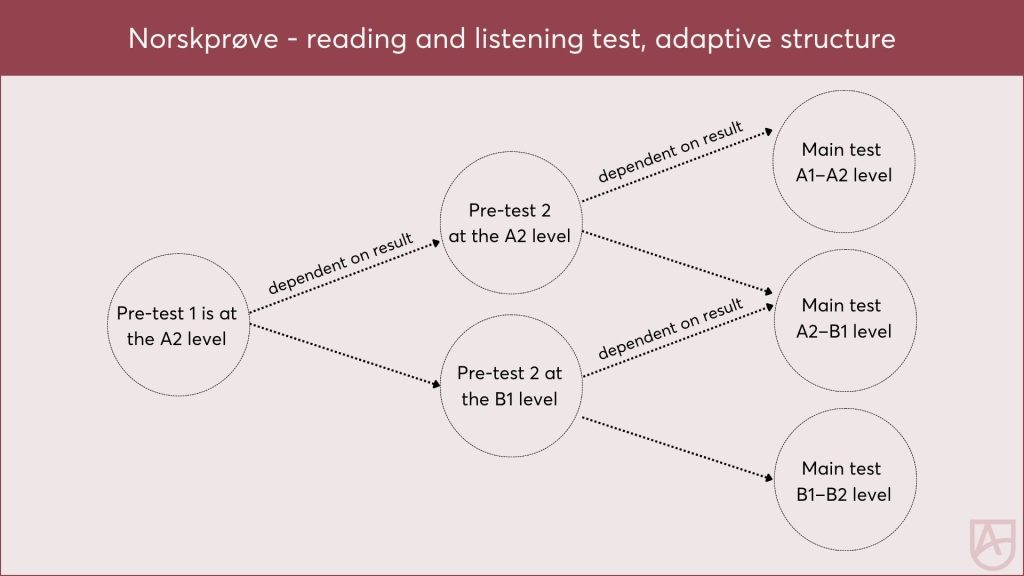
The reading test begins with a pre-test at the A2 level. Based on your performance in this pre-test, you’ll move on to either A2 or B1 level tasks. The more correct answers you give, the harder the tasks become and the more tasks you get.
Based on the total result of the først pre-tests, the candidate will get a main test at either the A1-A2, A2-B1, or B1-B2 level. Even if you give some wrong answers both in the pre-tests and main test, you can still get a high level result.
Examples of tasks (the reading test)
- Click on the correct picture
- Multiple-choice questions
- Find synonyms in the text
- Arrange paragraphs in the correct order
- Long text with questions about the text
- “Weed out” task (fill in missing words in the text)
Listening Test
Duration: Between 30 and 60 minutes
You’ll get tasks that test how well you understand Norwegian in audio format. The tasks play automatically, and you cannot go back to a previous task.
Adaptive structure
The listening test follows the same adaptive structure as the reading test: your results from the pre-test determine the difficulty of the main test.
Examples of tasks (the listening test)
- Click on the correct picture
- Multiple-choice questions
- Arrange pictures in the correct order
- Dialects (only at B2 level)*
*The dialects you might hear on the B2 level are from Eastern and Western Norway. In this task, you’ll listen to four people and answer who they are and what they are expressing.
Writing Test
Duration: A1-A2 and A2-B1: 90 minutes, B1-B2: 2 hours
The writing test is taken on a computer, and you cannot use a dictionary or any aids. You must answer all the tasks to receive a result.
It’s crucial to answer the questions asked; otherwise, you may receive the comment “ikke nok grunnlag for vurdering” (“not enough basis for assessment”) on your exam certificate. Make you sure you understand what the question is asking.
Every submission is evaluated by two graders, with a third being involved if the first two disagree. This ensures an objective assessment.
Adaptive structure
The writing test is not adaptive, so it is important that candidates choose the level that suits them.
Examples of tasks (the writing test)
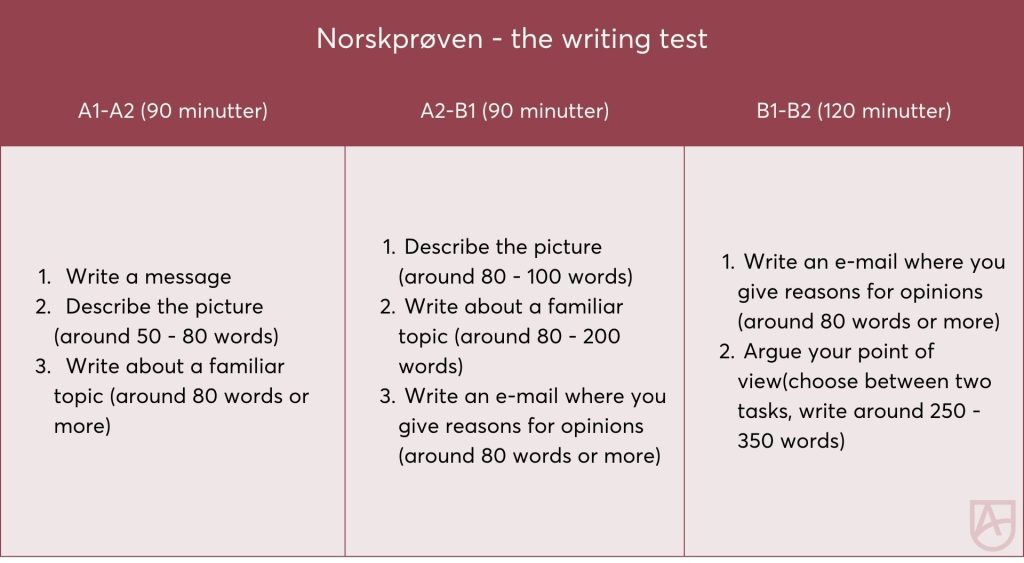
The difference between B1 and B2 (the writing test)
Both B1 and B2 are higher levels in Norwegian. The difference between the two levels is how advanced language you use in regard to text structure, reasoning, vocabulary and grammar. Here are some differences in the evaluation criteria (in norwegian):
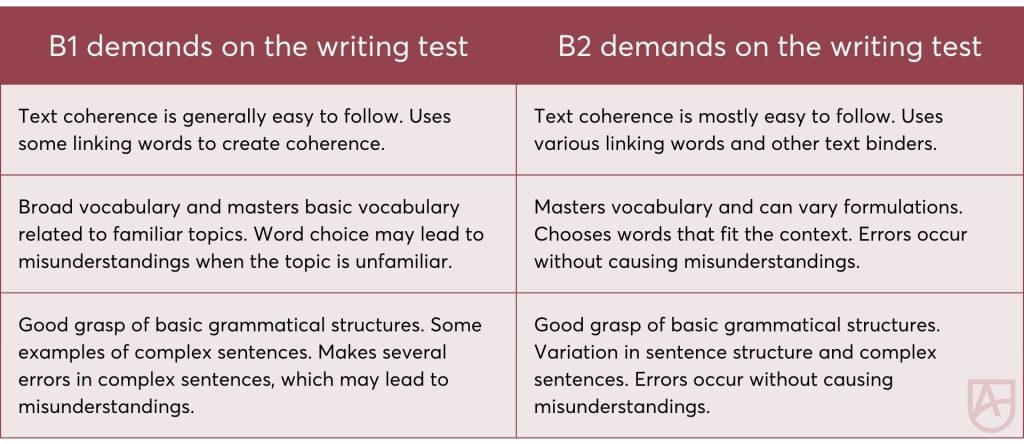
The writing test at the B2 level is considered difficult for many due to the demands for text coherence and variation in language use.
In our exam preparation course, we have activities where we practice varying sentences and connecting them in different ways. This is a useful skill that can be applied in both written and oral presentations.
As a student, you will also have four written assignments where your teacher will evaluate the texts using the same evaluation criteria as the Norskprøve examiners.
Oral Test
Duration: 20 -25 minutes
Here, your ability to speak Norwegian is tested. The graders assess fluency, pronunciation, vocabulary, and grammar—not your factual knowledge (how much you know about a topic), but only your language skills.
You’ll take the test with another candidate, but only one task is done in pairs.
Adaptive structure
During registration, the level is selected, but if the examiner believes that the candidate can manage a higher level, the candidate may receive an additional question from the higher level.
Examples of tasks (the oral test)
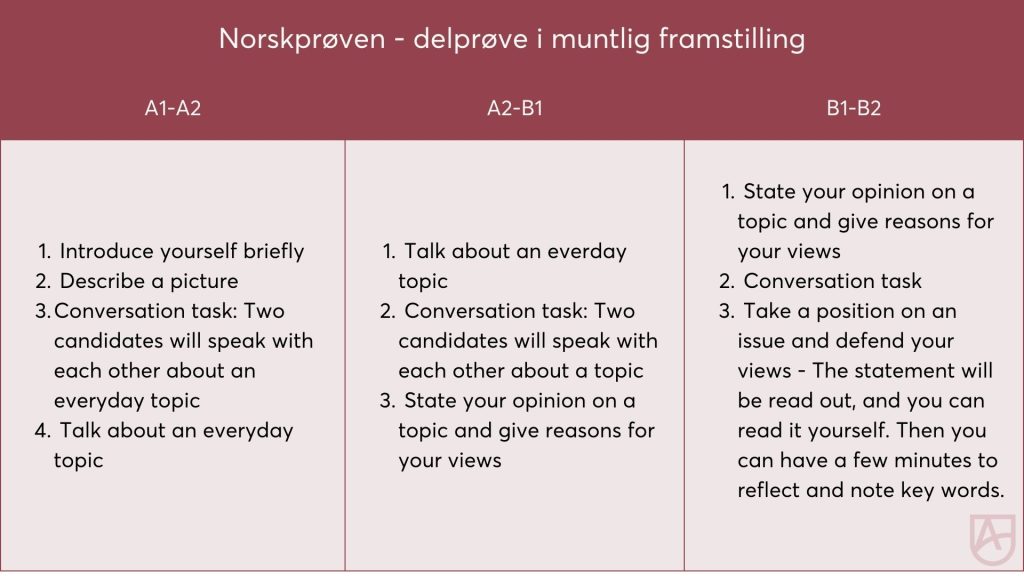
The third task at the B2 level (defending viewpoints) with a statement is known to be a bit challenging for candidates. Here are examples of how we practice argumentation in the B1-B2 preparation course:
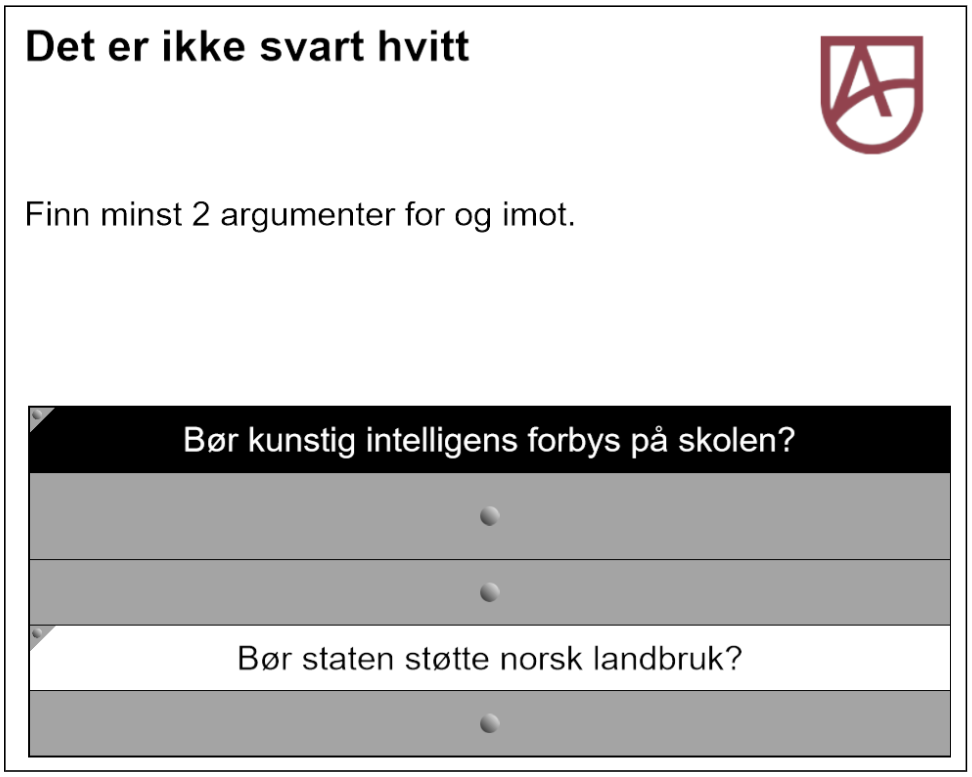
How to Register for the Norskprøve and Organization
The Norskprøve is held four times a year in municipalities across Norway. You can find the dates for each exam period on the official website of HK-dir (Directorate for Higher Education and Skills).
For each exam round, there is a registration period (when everyone must sign up for the exam) and an exam period (when everyone takes the exam). As the exam period approaches, all candidates will be informed of the order of the different parts of the exam, if they have registered for multiple parts at the same time.
Resultatet er en vurdering av kandidatens språknivå (fra under A1 til B2). The result is an evalutation of the candidate’s language level (from under A1 to B2). There is no failing grade in the Norskprøve: if you do not meet the B2 level requirements, you will automatically be assessed at the B1 level. Results are typically available a month after the exam period.
Tips for Preparing for the Test
The most important thing is to expose yourself to as much Norwegian as possible.
Newspapers, podcasts, series, and books help a lot in building your vocabulary. Practice Norwegian with everyone you can, whether it’s colleagues, friends, or strangers at language cafes. If you want a more structured preparation, we offer exam preparation courses at all levels. The course simulates tasks you’ll encounter on the test and focuses on strategies to develop all your language skills.
Good luck!
Written by Andrijana Pesic, Norwegian teacher at Alfaskolen.
Tags:

